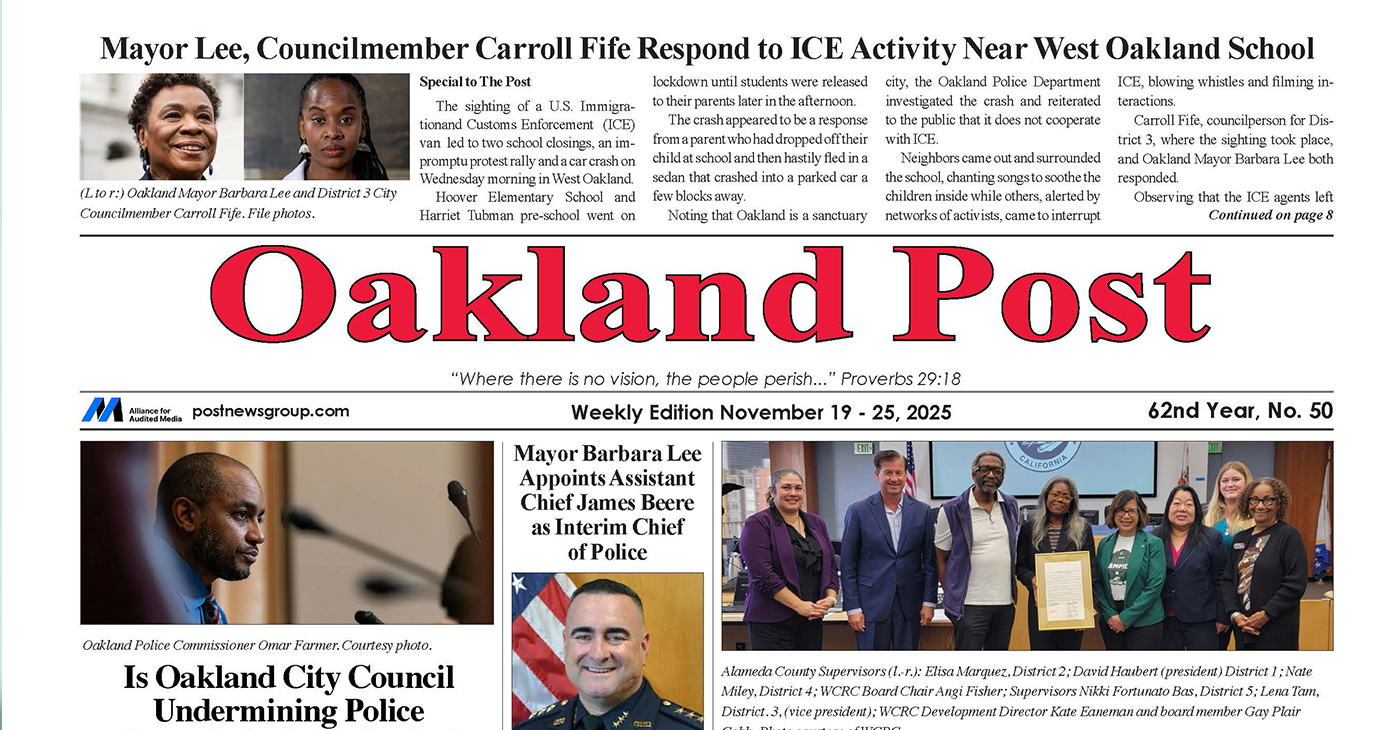Bay Area
New Alameda County Sheriff Yesenia Sanchez – History Making Latina
Supporters celebrated the victory of new Alameda County Sheriff Yesenia Sanchez in the Berkeley Hills on Sunday, March 12, at the home of Berkeley City Councilmember Sophie Hahn. “She stepped up for all of us,” Hahn said. “She stepped up for Alameda County. She stepped up for our values.”

By Carla Thomas
Supporters celebrated the victory of new Alameda County Sheriff Yesenia Sanchez in the Berkeley Hills on Sunday, March 12, at the home of Berkeley City Councilmember Sophie Hahn.
“She stepped up for all of us,” Hahn said. “She stepped up for Alameda County. She stepped up for our values.”
Berkeley Mayor Jesse Arguin, the first Latino mayor of Berkeley, said he was Sanchez’s first supporter and called her a change agent.
“Representation does matter,” said Arguin. “It’s important that the people who hold these positions come from the county and represent the diversity of the county. She was the only one that had the courage to go against Sheriff Ahern.”
The meet-and greet-event gave Sanchez an opportunity to discuss her new role and hear from the community on the changes they wish to see within the department internally, and externally throughout the community.
“I know the damaging effects that poverty and lack of access to resources and support systems can have on communities and how that impacts crime and safety,” Sanchez said. “I am committed to leading the Alameda County Sheriff’s Office with the utmost integrity, serving the community equitably and inclusively, and making sure the agency ensures safety in the community by investing in it.”
Sanchez plans to transform the system by implementing partnerships that can provide transportation, housing, and resources for the re-entry population. She also plans to strengthen access to public health care and mental health resources within the jails.
“This is more than a job, it’s a mission,” said Sanchez who sees transformation for now and the future. “The younger generations can now see what’s possible.”
In June 2022, then-Deputy Sheriff Yesenia Sanchez surprised many by her outright win in a three-way race against a well-entrenched incumbent to become Alameda County’s next sheriff.
Sanchez actually raced against her own boss and won. Risking her career and livelihood, Sanchez credits hard work, prayers, and God for such a victory.
Once Sanchez took her oath on January 3, she became the first Latina and woman to ever hold the office, making history.
Retiree Dawn Sullivan who worked as a detective under Sanchez said she was a great supervisor and Sanchez’s rise was no surprise to her.
“I’m so proud of her, she had the courage to run against her boss,” said Sullivan. “She’s already done a lot, but the changes she will make will be great for so many in the department and the community.”
Born in Hayward, and currently living in Livermore with her husband, Todd, Sanchez says she is a proud stepmom of three daughters. She’s also proud to be a Latina with southern and Mexican roots. Sanchez says her mother moved from Texas to California and her father immigrated from Mexico.
“My family shaped my core values of integrity, respect, accountability, transparency and openness,” she said.
By the age of 14, Sanchez’s parents had divorced, lost their home, and she her siblings worked to “help mom make ends meet.”
At the age of 18, Sanchez says she worked three jobs until she got an entry-level role of Sheriff’s Technician within the Alameda County Sheriff’s Office.
In the Sheriff’s Office, Sanchez rose through the ranks for over 20 years, serving as Deputy Sheriff, Sergeant, Lieutenant, and Captain at the (North County Jail), and the Glenn E. Dyer Detention Facility (GEDDF). Before her election, Sanchez’s most recent role included Division Commander, managing the Santa Rita Jail facility in Dublin.
Alameda County
Seth Curry Makes Impressive Debut with the Golden State Warriors
Seth looked comfortable in his new uniform, seamlessly fitting into the Warriors’ offensive and defensive system. He finished the night with an impressive 14 points, becoming one of the team’s top scorers for the game. Seth’s points came in a variety of ways – floaters, spot-up three-pointers, mid-range jumpers, and a handful of aggressive drives that kept the Oklahoma City Thunder defense on its heels.

By Y’Anad Burrell
Tuesday night was anything but ordinary for fans in San Francisco as Seth Curry made his highly anticipated debut as a new member of the Golden State Warriors. Seth didn’t disappoint, delivering a performance that not only showcased his scoring ability but also demonstrated his added value to the team.
At 35, the 12-year NBA veteran on Monday signed a contract to play with the Warriors for the rest of the season.
Seth looked comfortable in his new uniform, seamlessly fitting into the Warriors’ offensive and defensive system. He finished the night with an impressive 14 points, becoming one of the team’s top scorers for the game. Seth’s points came in a variety of ways – floaters, spot-up three-pointers, mid-range jumpers, and a handful of aggressive drives that kept the Oklahoma City Thunder defense on its heels.
One of the most memorable moments of the evening came before Seth even scored his first points. As he checked into the game, the Chase Center erupted into applause, with fans rising to their feet to give the newest Warrior a standing ovation.
The crowd’s reaction was a testament not only to Seth’s reputation as a sharpshooter but also to the excitement he brings to the Warriors. It was clear that fans quickly embraced Seth as one of their own, eager to see what he could bring to the team’s championship aspirations.
Warriors’ superstar Steph Curry – Seth’s brother – did not play due to an injury. One could only imagine what it would be like if the Curry brothers were on the court together. Magic in the making.
Seth’s debut proved to be a turning point for the Warriors. Not only did he contribute on the scoreboard, but he also brought a sense of confidence and composure to the floor.
While their loss last night, OKC 124 – GSW 112, Seth’s impact was a game-changer and there’s more yet to come. Beyond statistics, it was clear that Seth’s presence elevated the team’s performance, giving the Warriors a new force as they look to make a deep playoff run.
Activism
Oakland Post: Week of November 26 – December 2, 2025
The printed Weekly Edition of the Oakland Post: Week of November 26 – December 2, 2025

To enlarge your view of this issue, use the slider, magnifying glass icon or full page icon in the lower right corner of the browser window.
Activism
Oakland Post: Week of November 19 – 25, 2025
The printed Weekly Edition of the Oakland Post: Week of November 19 – 25, 2025

To enlarge your view of this issue, use the slider, magnifying glass icon or full page icon in the lower right corner of the browser window.
-

 Activism3 weeks ago
Activism3 weeks agoOakland Post: Week of November 12 – 18, 2025
-

 Activism4 weeks ago
Activism4 weeks agoOakland Post: Week of November 5 – 11, 2025
-

 Activism2 weeks ago
Activism2 weeks agoIN MEMORIAM: William ‘Bill’ Patterson, 94
-

 Activism3 weeks ago
Activism3 weeks agoHow Charles R. Drew University Navigated More Than $20 Million in Fed Cuts – Still Prioritizing Students and Community Health
-

 #NNPA BlackPress3 weeks ago
#NNPA BlackPress3 weeks agoThe Perfumed Hand of Hypocrisy: Trump Hosted Former Terror Suspect While America Condemns a Muslim Mayor
-

 Bay Area3 weeks ago
Bay Area3 weeks agoNo Justice in the Justice System
-

 #NNPA BlackPress3 weeks ago
#NNPA BlackPress3 weeks agoProtecting Pedophiles: The GOP’s Warped Crusade Against Its Own Lies
-

 #NNPA BlackPress2 weeks ago
#NNPA BlackPress2 weeks agoTrump’s Death Threat Rhetoric Sends Nation into Crisis



















































